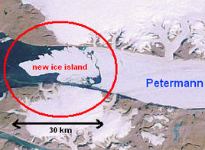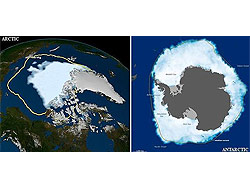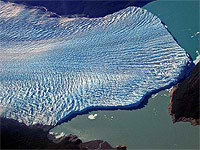El desprendimiento de hielo, que sucedió el pasado jueves y fue descubierto por el Servicio de Hielo Canadiense, es el mayor desde 1962 y se dirige hacia el estrecho de Nares, a unos 1 000 kilómetros al sur del Polo Norte, entre Groenlandia y Canadá.
El desprendimiento era un acontecimiento relativamente previsto, ya que el glaciar había crecido de manera significativa en los últimos siete u ocho años, aunque no se esperaba que el iceberg generado fuera tan grande. Los expertos estarán ahora alerta para ver si isla de hielo llega a tierra, se rompe en trozos más pequeños o se mueve hacia el sur, donde podría provocar problemas en las rutas marítimas, según ha indicado Andreas Muenchow, profesor de Ciencias del Mar e Ingeniería en la Universidad de Delaware e investigador en la zona donde sucedió el desprendimiento.
El iceberg mide 260 kilómetros cuadrados y su grosor es de casi la mitad del rascacielos neoyorquino Empire State, de 102 pisos, ha explicado Muenchow. "El agua dulce que contiene esta isla de hielo podría mantener el caudal de los ríos Delaware o Hudson por más de dos años" y "podría también proveer a todos los grifos públicos estadounidenses de agua por 120 días", ha añadido el experto.
Según Muenchow, es difícil saber si el evento se debe al calentamiento global porque solo hay registros del agua salada alrededor del glaciar desde 2003. El flujo de agua salada bajo los glaciares es una de las principales causas de los desprendimientos de hielo de Groenlanda. "Nadie puede decir que esto haya sido causado por el calentamiento global. Pero tampoco nadie puede decir que no haya sido por ello", ha concluido.
Noticia completa en Diario Hoy (Ecuador)
Enlaces a sitios |
| |
Climbing Magazine Climbing Magazine"s Web site contains more than 30 years of rock and ice climbing news, climber profiles, technical information, and gear reviews. You"ll also find message boards, photo galleries, and classifieds
| Cold Regions Bibliography Between 1999 and 2000, this project was carried out under an Interagency Agreement between the Federal Research Division of the Library of Congress and the U.S. Army Cold Regions Research and Engineering Laboratory (CRREL).
|
Descent into the Ice A tem of "glacionauts" ventures into a labyrinth of unexplored anda hazardous glacier caves on France"s Mont Blanc
| Glacier and Permafrost Hazards in Mountains – GAPHAZ Scientific Working Group of the International Association of Cryospheric Sciences (IACS) and the International Permafrost Association (IPA). Department of Geosciences University of Oslo
|
Glacier hazards The experience and data on glacier disasters in Switzerland has been systematically collected in the past two decades, and historical sources were analyzed.
| Glacier Hazards From Space Glacier hazards represent a continuous threat to human lives and infrastructure in mountain regions.
|
Glacier Hazards in Perú The floods, known in Perú as aluviónes, come with little or no warning and are composed of liquid mud that generally transports large rock boulders and blocks of ice.
| Glaciers and Glacier Hazards Glaciers and Glacier Hazards Glaciers and Ice Sheets and Volcanic Eruptions, USGS/Cascades Volcano Observatory, Vancouver, Washington
|
Glaciers online Glaciers online offers photos and summary explanations concerning glaciers from all over the world. The primary goal of our project is to enrich and stimulate the teaching of Earth Science and Physical Geography, in particular glaciology.. Jürg Alean & Mi
| Global Land Ice Measurements from Space GLIMS (Global Land Ice Measurements from Space) is a project designed to monitor the world"s glaciers primarily using data from optical satellite instruments, such as ASTER (Advanced Spaceborne Thermal Emission and reflection Radiometer).
|











 Imagen: NASA
Imagen: NASA





